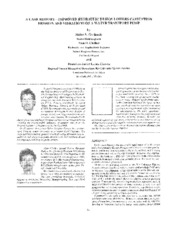| dc.description.abstract | In this case history, the successful application of well-known tools for hydraulic design changes and cavitation erosion prediction is presented. A description of the tools can be found in many publications and will not be repeated here. However, the application of the tools in a difficult field situation with unfavorable hydraulic boundary conditions is outlined and the resulting successful solution is presented. There are six pumping stations in the Rio Colorado Tijuana Aqueduct (water pipeline), which crosses northern Baja California in Mexico. The planning of the construction work did not adequately consider all the necessary hydraulic boundary conditions for the pipeline pumps; i.e., some of the suction reservoirs were built with a relatively small elevation relative to their pumping stations. Consequently, the existing available net positive suction head (NPSH) for the pumps of some stations is very low and marginal for satisfactory operation. Therefore, impellers are experiencing premature wear (repair/replacement after less than a year of operation), caused by cavitation erosion. Construction changes to the pipeline to increase the NPSH available were cost prohibitive. Hence, to extend the life expectancy of impellers, the customer placed an order with the OEM to develop an improved hydraulic design with respect to cavitation erosion. As nothing but the pump hydraulic could be changed, the new design would have to work under the existing, far less than optimum pipeline conditions, and compromises had to be found which would normally not be desirable for a new pipeline layout. Preliminary testing was to be done on the test bed and final testing was subject to a joint effort of the manufacturer and the user of the prototype pump installed and operating in the pipeline. A new impeller, with slightly modified rated flow conditions to adapt to effective plant conditions, and a steeper head – a capacity characteristic to avoid runout on the curve, was developed. Pump case changes were introduced at the inlet splitters and at the volute tips. Cavitation noise level to estimate erosion rates was measured as described by Guelich and Pace [1] and Guelich [2]. The original impeller’s life with respect to cavitation was estimated. A 65 to 70 percent probability of a 16,000 hr life was determined based on data from the new configuration, both on the test bed and in the pipeline, allowed the expected impeller life to be quantified. A guarantee to reach at least double the original time span for the worst operating conditions possible, at max flow, i.e., single pump operation, could be given. More than three years could be guaranteed for operation at plant design conditions and the chance to reach 4.5 years was estimated to be about 80 percent. The extrapolated life has been verified through a prorate erosion rate during a field inspection after almost 3000 hrs of operation. Vibration levels were significantly lowered due to the new hydraulic design with staggered impeller vanes. The comparison of old design and new design pump vibrations, taken during pipeline operation at the same station, indicate the clearly higher safety margin for the mechanical integrity of the upgraded machines. Additionally, as a byproduct, the efficiency has been increased by about two percent, as the pump best efficiency flow had been adjusted to the effective operating flow in the pipeline. | en |


